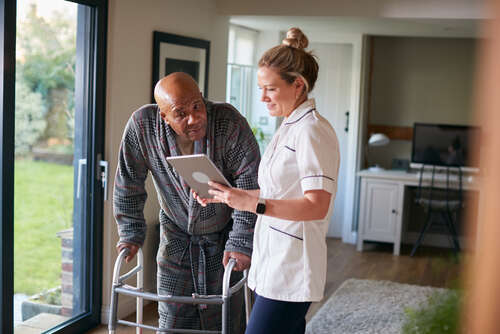
Only a handful of public services are delivering digital care in people’s homes at scale, according to a new report. This is despite the mounting evidence that digital transformation of health and care can reduce ambulance trips and help people remain at home.

According to the TEC Action Alliance, which involves more than 30 care organisations such as Care England, as well as technology suppliers, only 18% of over 2,000 respondents currently use telecare or telehealth services. Half of these people only use it fewer than once a week.
Its report, ‘Technology-Enabled Lives: Delivering Outcomes for People and Providers’, examines barriers to the widespread adoption of telehealth services and products, which includes conflict between shaping digital care around people’s needs and replicating services, economically, and at scale. Respondents also commented that they face barriers such as safety concerns, a lack of confidence and believe that digital care is expensive.
Over five months, the TEC Action Alliance also heard evidence from a range of people involved in care, as well as frontline workers and leaders in care, health, housing and local government. As well as hosting focus groups, in February 2023, a survey was conducted that found that only 8% of frontline care staff and those who used care services felt negatively about using technology for health and care purposes.
However, only 14% used a monitoring or personal alarm compared to 92% who used their smartphones on a daily basis.
Telehealth and digital care have positive impacts on public services and patients
Technology-enabled care (TEC) services have been found to reduce burdens on public services such as NHS England and social care. TEC Action Alliance’s report showed that ambulance trips to A&E reduced to 68% when TEC responder teams handled emergency calls. It also enabled 85% of people to remain at home.
TEC responder teams also help cut emergency response times to 30 minutes and help to refer 40% of people to community services rather than formal social care. This is compared to 7% before the pandemic.
Alyson Scurfield, CEO, TEC Services Association (TSA) and co-chair, TEC Action Alliance said that during this time of immense pressure on NHS and social care services, digital care services can put “power in the hands of people” by helping them to self-manage their own health.
“We’ve found some pockets of good technology-enabled care but still no national adoption,” she explained. “To address this, we must understand how technology-enabled care can be better personalised and scaled.”
There is a strong appetite to use digital care, but it isn’t being realised
While 86% of respondents told TEC Action Alliance that they would likely use digital care services and products in the future, the organisation says that evidence points to public sector organisations not drawing on its potential.
Only 18% of respondents currently use telecare or telehealth services across the country, with TEC Action Alliance saying that they have found no evidence of large-scale implementation of digital care solutions. In its report, they have called on care commissioners and suppliers to listen carefully to what people who could benefit from the solutions want and co-produce their services and products with them. They add that the focus needs to be on “personal needs”.
Clenton Farquharson MBE, chair of Think Local Act Personal (TLAP) and co-chair of the TEC Action Alliance said: “Currently, we talk about digitising social care, health and housing: re-engineering systems and processes. What I don’t hear about are ‘technology-enabled lives’, where the ambitions and aspirations of the individual come first, made possible by digital.”
He adds that the report is an opportunity to “rethink technology-enabled care” and understand the requirements: “It’s a chance to step back from the equipment, solutions and systems and re-evaluate what really matters.”
TEC Action Alliance’s report asks that health and care data be shared more widely to enable a joined-up response more locally and integrate care technology within broader NHS plans around virtual wards. This month, NHS England announced it would create an additional 3,000 virtual ward beds by Winter 2023 through its £150m TEC Services 2 framework agreement.
Slow and inadequate progress is proving costly for health and social care
Back in June 2022, the Department for Health and Social Care (DHSC) announced its vision to transform health and care using digital technology. It published a plan to accelerate the expansion of digital technology use within the two sectors, including improving access to information through the NHS App and NHS website for people and their care teams.
It also said it would increase the availability of remote monitoring to support a further half a million people by March 2023, on top of the 280,000 people already using it at home or in care homes. The DHSC’s plans have had £2bn earmarked, plus £150m to support digital transformation in social care.
However, the Commons Health and Care select committee found that the progress made by the NHS in digitally transforming its organisation and services was “inadequate”. It reviewed all the commitments made by the UK government and found that overall key objectives had not been met.
Think tank Policy Connect also found that local authorities and NHS England lacked ambition and vision when it came to implementing smart home technology to help older and disabled people live more independently.






